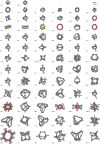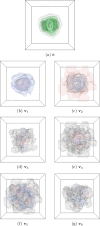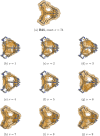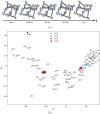Eigencages: Learning a Latent Space of Porous Cage Molecules
- PMID: 30648150
- PMCID: PMC6311689
- DOI: 10.1021/acscentsci.8b00638
Eigencages: Learning a Latent Space of Porous Cage Molecules
Abstract
Porous organic cage molecules harbor nanosized cavities that can selectively adsorb gas molecules, lending them applications in separations and sensing. The geometry of the cavity strongly influences their adsorptive selectivity. For comparing cages and predicting their adsorption properties, we embed/encode a set of 74 porous organic cage molecules into a low-dimensional, latent "cage space" on the basis of their intrinsic porosity. We first computationally scan each cage to generate a three-dimensional (3D) image of its porosity. Leveraging the singular value decomposition, in an unsupervised manner, we then learn across all cages an approximate, lower-dimensional subspace in which the 3D porosity images congregate. The "eigencages" are the set of orthogonal, characteristic 3D porosity images that span this lower-dimensional subspace, ordered in terms of importance. A latent representation/encoding of each cage follows by approximately expressing it as a combination of the eigencages. We show that the learned encoding captures salient features of the cavities of porous cages and is predictive of properties of the cages that arise from cavity shape. Our methods could be applied to learn latent representations of cavities within other classes of porous materials and of shapes of molecules in general.
Conflict of interest statement
The authors declare no competing financial interest.
Figures










 . Each fluctuating cage
explores a latent region determined by the set of
cavity shapes explored while
undergoing thermal fluctuations. MC6, an outlier, is
omitted to avoid stretched axes.
. Each fluctuating cage
explores a latent region determined by the set of
cavity shapes explored while
undergoing thermal fluctuations. MC6, an outlier, is
omitted to avoid stretched axes.References
-
- Brueske S.; Kramer C.; Fisher A.. Bandwidth Study on Energy Use and Potential Energy Saving Opportunities in U.S. Petroleum Refining; Energetics Incorporated, prepared for the U.S. Department of Energy Office of Energy Efficiency and Renewable Energy Advanced Manufacturing Office 2015.
-
- Hasell T.; Cooper A. I. Porous organic cages: soluble, modular and molecular pores. Nat. Rev. Mater. 2016, 1, 16053.10.1038/natrevmats.2016.53. - DOI
LinkOut - more resources
Full Text Sources

